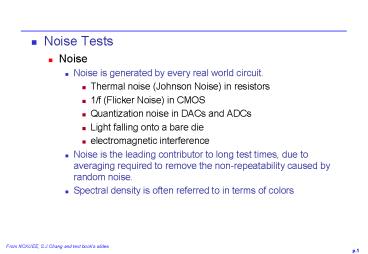Noise Tests
1 / 8
Title: Noise Tests
1
- Noise Tests
- Noise
- Noise is generated by every real world circuit.
- Thermal noise (Johnson Noise) in resistors
- 1/f (Flicker Noise) in CMOS
- Quantization noise in DACs and ADCs
- Light falling onto a bare die
- electromagnetic interference
- Noise is the leading contributor to long test
times, due to averaging required to remove the
non-repeatability caused by random noise. - Spectral density is often referred to in terms of
colors
2
- Noise Tests
- Noise - cont.
- White noise, like white light has RMS voltage
constant in any band of frequencies. White noise
exhibits a voltage distribution that is very
close to a Gaussian distribution. It is this
fact that many measurement histograms display a
Gaussian distribution. Pink noise, by contrast,
is noise that is weighted more heavily at low
frequencies. - Sometimes noise is defined as any signal
component other than the primary test tone. This
clumps all other distortions and noises into one
measurement, which allows very limited
debuggability. - A better solution is to identify all failure
modes independently and test for each
individually - A combined Noise measurement can always be
calculated as a measure of quality for the DUT
from separate results.
3
- Noise Tests
- Idle Channel Noise
- A measurement of the noise generated by the
circuit itself, plus noise injected from external
circuits or sources through a variety of coupling
mechanisms. - Inputs are usually shorted or grounded. Ideally,
the output should be placed into low noise state. - Using DSP based testing, output noise is measured
by digitizing the output of the circuit and
performing a noise calculation on the captured
samples. - Idle channel noise can be expressed in many
different units. - Simplest is to calculate the RMS voltage level
from the captured samples
4
- Noise Tests
- Idle Channel Noise - cont.
- It is important to remember that the bandwidth of
the digitizer is extremely important - the larger
the bandwidth, the larger the RMS of the noise,
so it is critical to express the noise in terms
of RMS voltage over a specified bandwidth. - Idle channel noise is also specified in V/?Hz -
the RMS voltage is divided by the square root of
the frequency span of the bandwidth of the
digitizer or voltmeter. - THIS NUMBER IS REFERRED
TO AS THE SPECTRAL DENSITY and allows
back-calculation of the idle channel noise over a
different bandwidth.
5
- Noise Tests
- Signal to Noise and Signal to Noise Distortion
- Signal to noise ratio is another way to measure
the noise in an analog or mixed-signal channel - Different from idle channel noise in that it
measures noise in the presence of a test signal,
usually a sine wave. - In a purely analog channel, this should not
change the noise value - if an ACD or DAC are
present, quantization noise is introduced into
the calculation. - Signal to noise ratio is often measured using the
same data collected during the gain and signal to
distortion tests. - Defined as the ratio of the primary signal
divided by all non-signal components.
6
- Noise Tests
- Spurious Free Dynamic Range
- Spurious free dynamic range is a specification
that is critical to audio circuits as well as
telecom circuits that must pass FCC
certifications. - A spur is defined as a noise component that is
confined to a single frequency. - Caused by clock feedthrough, sigma-delta
converter self tones, stray oscillations etc. - Spurs are much more noticeable by the human ear
than other types of noise. - Also, spurs are mixed with transmitted signals in
cellular phones which may interfere with calls on
other cellular phones.
7
- Noise Tests
- Spurious Free Dynamic Range - cont.
- A spur shows up on the FFT or on a spectrum
analyzer as a spike in the frequency domain. - Spurious free dynamic range is defined as the
difference in decibels between the 0 dB signal
level (the carrier level) and the maximum spur in
the frequency domain.
8
- Weighting filters
- Weighting filters can be applied to any FFT
output before calculations are performed. - Usually designed to mimic the final application -
like the human ear for cellular phones. - ANSI A-weighting filter
- psophometric filter
- C-message weighting filter
- Since the filters are only specified at certain
frequencies, some interpolation is required -
usually a straight line approximation on a
log-log plot - To save test time, weighted filter gain values
should only be calculated once, during the first
execution of the test program and stored for
future use.































